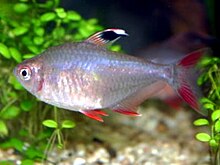Characiformes
| Characiformes Temporal range: [1]
| |
|---|---|

| |
| Hyphessobrycon bentosi | |
| Scientific classification | |
| Domain: | Eukaryota |
| Kingdom: | Animalia |
| Phylum: | Chordata |
| Class: | Actinopterygii |
| (unranked): | Otophysi
|
| Order: | Characiformes Regan, 1911 |
| Type species | |
| Charax gibbosus | |
| Families | |
| |
Characiformes /ˈkærəsɪfɔːrmiːz/ is an order of ray-finned fish, comprising the characins and their allies. Grouped in 18 recognized families, more than 2000 different species are described, including the well-known piranha and tetras.[1]
Taxonomy
The Characiformes form part of a series called the
Originally, the characins were all grouped within a single family, the
Evolution
The oldest characiform is Santanichthys of the Early Cretaceous (Albian Age) of Brazil. All extant species live in fresh water, but this Cretaceous species probably lived in either brackish or marine water. Many other fossils are also known.[1] The Characiformes likely first diversified during the Cretaceous Period, though fossils are poorly known.[1] During the Cretaceous Period, the rift between South America and Africa would be forming; this may explain the contrast in diversity between the two continents. Their low diversity in Africa may explain why some primitive fish families and the Cypriniformes coexist with them whereas they are absent in South America, where these fish may have been driven extinct.[2] The characiforms had not spread into Africa soon enough to also reach the land connection between Africa and Asia.[2] The earliest they could have spread into Central America was the late Miocene.[2]
Phylogeny
Below is a phylogeny of living Characiformes based on Betancur-Rodriguez et al. 2017[4] and Nelson, Grande & Wilson 2016.[5]
| Characiformes |
| ||||||||||||||||||||||||||||||||||||||||||||||||||||||||||||||||||||||||||||||||||||||||||||||||||||||||||||||||||||||||||||||||||||
Description
Characins possess a
The largest characins are
Distribution and habitat
Characins are most diverse in the
Relationship to humans
A few characins become quite large, and are important as food or game.[1] Most, however, are small shoaling fish. Many species commonly called tetras are popular in aquaria[9] because of their bright colors, general hardiness, and tolerance towards other fish in community tanks.[1]
References
- ^ ISBN 0-471-25031-7.); Buckup P.A.: "Relationships of the Characidiinae and phylogeny of characiform fishes (Teleostei: Ostariophysi)", Phylogeny and Classification of Neotropical Fishes, L.R. Malabarba, R.E. Reis, R.P. Vari, Z.M. Lucena, eds. (Porto Alegre: Edipucr) 1998:123-144.
{{cite book}}: CS1 maint: multiple names: authors list (link - ^ S2CID 84010604.
- ^ a b Claudio Oliveira, Gleisy S Avelino, Kelly T Abe, Tatiane C Mariguela, Ricardo C Benine, Guillermo Ortí, Richard P Vari and Ricardo M Corrêa e Castro,"Phylogenetic relationships within the speciose family Characidae (Teleostei: Ostariophysi: Characiformes) based on multilocus analysis and extensive ingroup sampling", BMC Evolutionary Biology 2011, 11:275).
- PMID 28683774.
- ISBN 9781118342336.
- ^ Froese, Rainer, and Daniel Pauly, eds. (2014). "Characiformes" in FishBase. February 2014 version.
- ^ "Fishing Worldrecords-characins-salminus franciscanus".
- ISBN 0-12-547665-5.
- ^ Isbrücker, I. J. H.; Nijssen, H. (1988). "Review of the South American characiform fish genus Chilodus, with description of a new species, C. gracilis (Pisces, Characiformes, Chilodontidae)". Beaufortia. 38 (3): 47–56.
